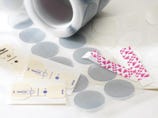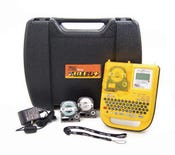Spotlight on Printing, Labeling, and Marking
May 24, 2010
Track-and-trace technology
Used on pouches and packages, a supplier's track-and-trace technology can be employed to print 2-D bar codes, custom codes, and other mass-serialization codes for authenticating products and tracking them through the supply chain. Offered by an FDA-registered and CGMP-compliant medical device manufacturer, the technology can be layered with overt and covert security features and tamper-indicating void patterns for extra protection. Capabilities include island placement for transdermal and placebo patches, multiple-panel booklet labels, extended-content labels, laminating, custom die-cutting, printing, kit assembly, and cold-seal packaging.
ATL
Menomonee Falls, WI
www.atlco.com Heat-shrink-tube, bar code, and adhesive-label printer
Heat-shrink-tube, bar code, and adhesive-label printer
Designed for medical device manufacturing operations, a system can be used to print color-coded labels, bar codes, heat-shrink tubes, and wire-wrap identification labels. The BEE3+ accommodates a greater variety of heat-shrink-tube widths than the original model, including all 11 LabelShop heat-shrink-tube sizes and colors and a new wide-format ½-in. size. The printer kit includes a printer with a rubber edge guard, a dc auto or ac adapter, a ½-in. heat-shrink-tube cartridge, a ½-in. tape cartridge, a wrist strap, and six AA batteries. The system can print six bar code formats and approximately 1000 symbols, including ASNI, safety, biohazard, and other symbols.
K-Sun Corp.
Somerset, WI
www.ksun.com
Label applicator
A label applicator with a high-speed servomotor drive can outperform stepper and clutch/brake applicators in speed, accuracy, and dependability, according to its manufacturer. Capable of attaining speeds of up to 1500 linear in./min and, depending on the label and product size, approximately 250 labels per minute, the #1510 applicator offers a range of features. Among them are automatic setup capability, user-friendly operating software, a heavy-duty industrial design, 25 I/O points that enable easy integration with other machines, two serial ports, a missing-label detector, and a touch screen user interface. The applicator is also available in right- and left-hand models and can easily be supported and serviced in the field. Labels can be applied using tamp, wipe-on, flag, blow, corner-wrap, or swing-tamp methods.
Label Mill/Coding Solutions Inc.
St. Charles, IL
www.labelmill.com Laser marking and engraving
Laser marking and engraving
Featuring pulse frequencies of several-hundred Hertz and wavelengths as short as 193 nm, a manufacturer's excimer lasers perform cold marking and cold engraving processes on plastic, glass, ceramic, and quartz. As a cold technology, the lasers provide nonthermal interaction and ablative removal characteristics at the short ultraviolet wavelength. As a result, most types of precision marks with feature resolutions on the order of a few microns can be produced on any class of optically transparent materials, according to the manufacturer.
Coherent Inc.
Santa Clara, CA
www.coherent.com
Fiber laser coders
Compact and fast, a company's fiber laser coders are suitable for such applications as direct parts marking and unique identification coding on a variety of metal, plastic, and hard-to-mark medical devices. Providing 10 and 20 W of output power and speeds of up to 350 and 700 characters per second, respectively, the Videojet 7210 and 7310 fiber laser coders feature a small marking head and straight-out or 90° beam options. They feature quick setup capability, easy integration into complex production lines, remote application diagnostics and controls that do not require a PC, and an air-cooled optical fiber as the laser medium. In addition, both coders can apply complex variable data, such as high-quality identification matrix codes, bar codes, logos, and serial numbers, on moving and static products. They also do not require the use of consumables such as inks, solvents, or compressed air.
Videojet Technologies Inc.
Wood Dale, IL
www.videojet.com Label-processing system
Label-processing system
A label-processing system
is designed for the automatic application of labels to bags, flats, and pouches with or without zippers. The compact Labelmaster printer and applicator can meet the demands of medical device packagers. It is PC controlled and is compatible with most off-the-shelf label software programs. The system can apply blank or partially preprinted labels with a maximum size of 6 × 10 in., with or without die-cut inserts, to pouches with a maximum size of 17 × 17 in. Minimal size changeovers and operator training are required.
About Packaging Robotics Inc.
Thornton, CO
www.aboutpackagingrobotics.com Laser marking systems
Laser marking systems
A manufacturer offers computer-controlled, noncontact material-modification laser systems ranging in size from small-footprint, self-contained units for low- to medium-volume production runs to extended-size machines for medium- to high-volume production runs. Designed for product development, all of the company's systems can process a range of materials. Using patented high-power-density focusing optics, the laser systems can directly mark metals such as stainless steel, chrome steel, and titanium without the need for metal-marking compounds. Their cells can permanently mark medical components, surgical instruments, and engineered plastics. They can be used to make labels, identification tags, bar codes, 2-D data-matrix codes, and nameplates, in addition to pad-printing plates, prototypes, 2-D buildups, and 3-D textures.
Universal Laser Systems Inc.
Scottsdale, AZ
www.ulsindustrial.com
You May Also Like

